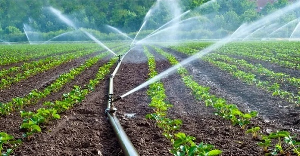 The World Bank noted Ghana possesses substantial irrigation potential
The World Bank noted Ghana possesses substantial irrigation potential
The World Bank has said only three percent of cultivated land in the country is irrigated – a phenomenon the Bank indicates could stifle Ghana’s agriculture resilience.
In its Africa Can End Poverty report under the ‘Delivering Irrigation for Enhanced Productivity and Climate Resilience in Ghana’ category, the Bank disclosed that climate change poses unprecedented challenges to Ghanaian agriculture.
Climate change, according to the World Bank, reduces the predictability of rainfall, increases temperatures, and lengthens the duration of dry periods.
The World Bank noted Ghana possesses substantial irrigation potential, with estimates of irrigable land spanning from 360,000 to 1.9 million hectares; but just about three percent of cultivated land is properly irrigated for agriculture.
Underutiliation of the said potential, according to the Bank, risks farmers facing the brunt of shifting weather patterns and extreme events as the country’s farming system is predominantly rain-fed.
Ghana has 104 central pivot irrigation systems, each covering a minimum of 40 acres: but about 98 percent of these systems and facilities are non-functional.
Over the last decade, the World Bank has committed more than US$200million in loans and grants to meet Ghana’s climate smart agriculture needs.
A chunk of these monies were meant to revitalise abandoned irrigation schemes across the country, but some stakeholders believe these funds have been squandered.
Indeed, an alarming US$11.9million was spent on mobiliation to kick-start construction of the US$993million-worth Pwalugu multi-purpose dam, only for the project to fail.
Some tangible results
However, some successes were achieved under the Ghana Commercial Agriculture Project (GCAP) – the project reaching some 14,264 beneficiaries, of which 37 percent were women.
GCAP invested US$62million in physical rehabilitation and modernisation of public irrigation and drainage infrastructure in two irrigation schemes located on either side of the Volta River: the Kpong Irrigation Scheme (KIS) and the Kpong Left Bank Irrigation Scheme (KLBIS).
Both schemes provide water to irrigate 7,391 hectares cropped by 2,835 smallholders (41 percent female) and several commercial farmers.
The main crop cultivated on these irrigation schemes is rice. GCAP’s interventions were critical to building climate resilience as they enhanced water security, made infrastructure more climate-resilient and strengthened farmers’ adaptive capacity.
More opportunities to prioritise irrigation
Also, as a beneficiary of the World Bank’s West Africa regional Food Systems Resilience Programme’s (FSRP-2) second phase approved in 2022, the country has an opportunity to prioritise irrigation in order to mitigate the ever-escalating impacts of climate change.
The FSRP-2 supports Chad, Ghana and Sierra Leone in increasing their preparedness against food insecurity and improving the resilience of their food systems. Among other interventions, FSRP-2 envisions expanding the irrigation rehabilitation and modernisation work carried out under GCAP in the country and consolidating its impacts on productivity and climate resilience while reaching more smallholders.